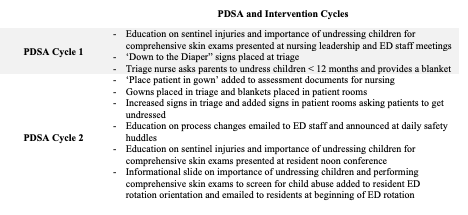Emergency Medicine: Quality Improvement
Category: Abstract Submission
Emergency Medicine XIV
47 - Down to the Diaper: Improving Patient Exposure to Augment Sentinel Injury Screening in a Pediatric Emergency Department
Monday, April 25, 2022
3:30 PM - 6:00 PM US MT
Poster Number: 47
Publication Number: 47.407
Publication Number: 47.407
Dana R. Tower, University of Utah Department of Pediatrics, Salt Lake City, UT, United States; Theresa T. Tran, Primary Children's Hospital/University of Utah, Salt Lake City, UT, United States; Nathaniel E. Hayward, University of Utah, Salt Lake City, UT, United States; Antoinette Laskey, University of Utah School of Medicine, Salt Lake City, UT, United States; Bruce E. Herman, University of Utah Department of Pediatrics, Salt Lake City, UT, United States; Joyce V. Soprano, University of Utah School of Medicine, Salt Lake City, UT, United States; Michael D. Johnson, University of Utah School of Medicine, Salt Lake City, UT, United States; Roni D. Lane, University of Utah School of Medicine, Salt Lake City, UT, United States

Dana R. Tower, MD
Chief Resident, Visiting Instructor
University of Utah Department of Pediatrics
Salt Lake City, Utah, United States
Presenting Author(s)
Background: Bruising in pre-mobile children, although rare, is highly concerning for child abuse. It is imperative to identify sentinel injuries prior to children presenting with significant morbidity or mortality due to escalating abuse. This quality improvement (QI) initiative was conducted in a pediatric emergency department (ED) with no formal child abuse screening or patient exposure process. Extra effort is required to undress children prior to physical examination and is a barrier to identifying sentinel injuries. By implementing a full patient exposure process, we aim to increase comprehensive skin exams where all clothes are removed to screen for child abuse.
Objective: Increase the percentage of infants < 12 months undressed ‘down to the diaper’ prior to provider physical examination from 41% to 80% and to increase comprehensive skin exams to screen for child abuse from 75% to 90% in the ED by March 2021.
Design/Methods: The intervention was performed at Primary Children’s Hospital ED, a Level I Pediatric Trauma Center. A survey was completed by one provider (attending, fellow, or nurse practitioner) for each patient encounter ( < 12 months) regardless of chief complaint. This survey assessed if the patient was undressed prior to the provider entering the room and what portion of the physical exam was completed. There were two plan-do-study-act (PDSA) cycles in which surveys were collected (Table 1). Survey data regarding process adherence was analyzed using Statistical Process Control (SPC) charts.
Results: There was a notable increase in the proportion of patients undressed ‘down to the diaper’ prior to the provider entering the room from 41% to 66% (Figure 1) and an increase in the number of comprehensive skin exams from 76% to 87% (Table 2).Conclusion(s): We demonstrated a notable improvement in the number of children receiving comprehensive skin exams by implementing a QI initiative to undress children ‘down to the diaper’ in our pediatric ED. While we did not meet our initial aim statement, this intervention is impactful and could be used in other ED settings to increased comprehensive skin exams to screen for physical child abuse.
Dana Tower CVDana_Tower_CV_12.29.21.pdf
Table 1 Description of PDSA Cycles & Interventions
Description of PDSA Cycles & Interventions
Objective: Increase the percentage of infants < 12 months undressed ‘down to the diaper’ prior to provider physical examination from 41% to 80% and to increase comprehensive skin exams to screen for child abuse from 75% to 90% in the ED by March 2021.
Design/Methods: The intervention was performed at Primary Children’s Hospital ED, a Level I Pediatric Trauma Center. A survey was completed by one provider (attending, fellow, or nurse practitioner) for each patient encounter ( < 12 months) regardless of chief complaint. This survey assessed if the patient was undressed prior to the provider entering the room and what portion of the physical exam was completed. There were two plan-do-study-act (PDSA) cycles in which surveys were collected (Table 1). Survey data regarding process adherence was analyzed using Statistical Process Control (SPC) charts.
Results: There was a notable increase in the proportion of patients undressed ‘down to the diaper’ prior to the provider entering the room from 41% to 66% (Figure 1) and an increase in the number of comprehensive skin exams from 76% to 87% (Table 2).Conclusion(s): We demonstrated a notable improvement in the number of children receiving comprehensive skin exams by implementing a QI initiative to undress children ‘down to the diaper’ in our pediatric ED. While we did not meet our initial aim statement, this intervention is impactful and could be used in other ED settings to increased comprehensive skin exams to screen for physical child abuse.
Dana Tower CVDana_Tower_CV_12.29.21.pdf
Table 1
 Description of PDSA Cycles & Interventions
Description of PDSA Cycles & Interventions